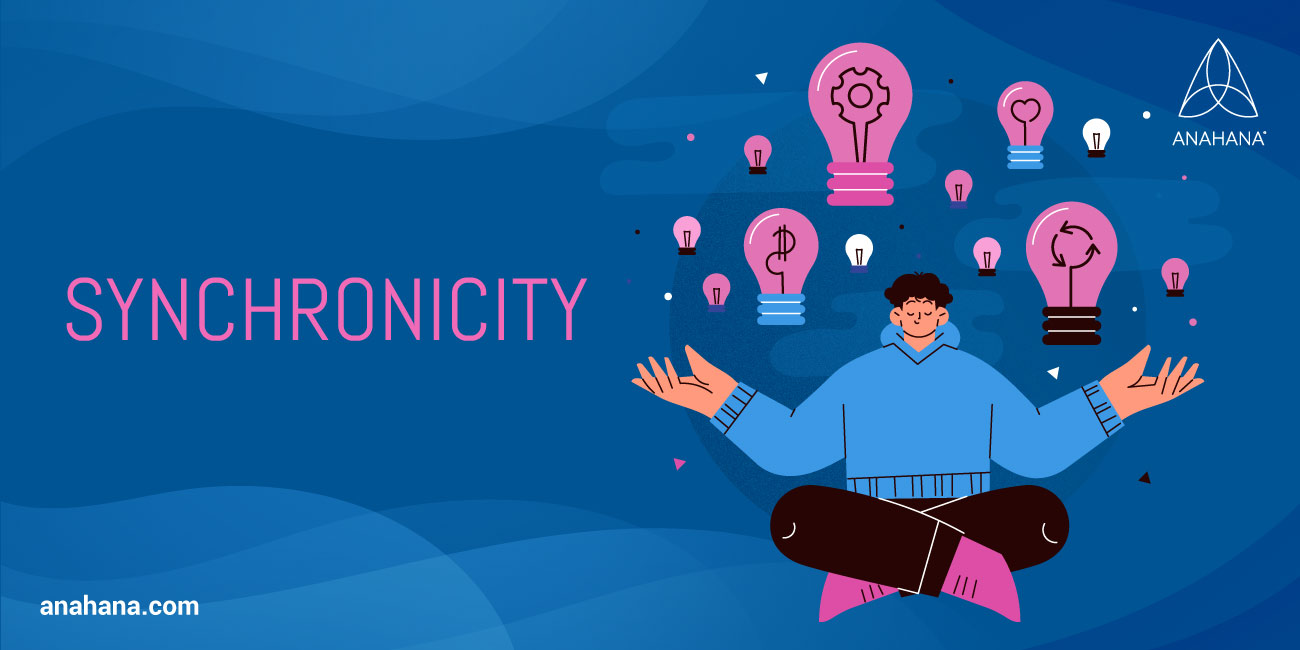Imposter Syndrome
If an individual is experiencing unfounded feelings of incompetence and self-doubt, it could be an indication of imposter syndrome.
Learn more about human thinking patterns and the concept of synchronicity. Understand the experience of synchronicity and how to interpret experiences to achieve spiritual transformation and personal growth.
 Synchronicity is a phenomenon where individuals interpret two unrelated and separate experiences as being related or intertwined, but mechanisms of causality cannot explain them.
Synchronicity is a phenomenon where individuals interpret two unrelated and separate experiences as being related or intertwined, but mechanisms of causality cannot explain them.
Although it may be impossible to test synchronicities scientifically, individuals might seek spiritual meaning and signs behind synchronicity. Researchers and scientists believe that such situations are more likely to be a meaningful coincidence that an individual deems meaningful due to human thinking patterns like confirmation bias.
When individuals experience synchronicity, they describe these experiences as "miracles," "signs from heavens, mystical instances of soul connections and guidance from one's soul and spirits.”
Synchronicity manifests in various forms; for example, individuals report hearing or viewing meaningful words, sounds, names and symbols. Individuals may see the same number, words or events in multiple places, possibly due to aspects of human thinking such as confirmation or hindsight bias. There is a different probability of the numbers and words appearing - some repeated encounters and thinking patterns are statistically less likely to appear than others, which helps ascribe meaning to such coincidences, labelling them as synchronicity.
The term synchronicity can have different meanings for various individuals. They show up in different forms for each individual. Common examples of synchronicities include numbers, colors, animals, people, symbols, golden opportunities, musical messages, dreams, sounds, nature's unexplainable phenomena, and divine timing.
Individuals believe synchronicities are a form of guidance from the higher soul or self. It directs an individual's steps and decisions in life as they experience a spiritual awakening.
Synchronicity is most commonly experienced by individuals who report being on a spiritual journey. They provide guidance and a way of confirmation and hope for individuals on the path to enlightenment and self-transformation.
Psychologist Carl Gustav Jung developed the term synchronicity in the 1990s. He defined the idea of synchronicity as "meaningful coincidences of two or more events." Coincidences refer to a series of events that happen without an apparent cause.
Modern research describes synchronicity as an individual's subjective experience that coincidences between the outside world and an individual's mind might be unrelated but may have an unknown connection.
Carl Jung believed synchronicity was a healthy and necessary function of the mind. However, scientists, today believe that these coincidences are non-scientific. Many other factors account for these experiences, including seeking information to ignore information that challenges their thinking and supports their ideas. The concepts continue to be studied by psychoanalysts and physicists.
Jung's theory also described psychological synchronicity as the principle that drives individuals towards or negates their concepts of the collective unconscious and the potential for self-actualization.
Jung's writings also believed synchronicities are linked to human destiny and chaos theory, which states that synchronicities manifest an underlying order in which everything that fascinates individuals eventually becomes meaningful.
Six theories explain synchronicities: behavioral economists, skeptics, quantum physics, psychologists, and everyday spiritual folks.
Behavioral economists believe individuals experience synchronicity due to confirmation bias as they actively seek what confirms their beliefs and thoughts.
According to skeptics, synchronicity is also referred to as Apophenia or the act of observing patterns and connections in meaningless and random data or events.
Quantum physicists believe synchronicity can be attributed to universal consciousness, supporting the theory of quantum entanglement. They define quantum entanglement as the physical phenomenon that explains synchronicity.
The concept of morphic resonance in biology, as introduced by Rupert Sheldrake's work, is similar to synchronicity principles, whereby self-organizing systems can inherit memory systems.
Spiritual folks believe that synchronicities are meaningful coincidences that are signs from the soul or the higher self. Psychology, especially the concepts that follow Carl Jung's theories, believes synchronicity stems from the collective unconscious and the unconscious mind.
 Humans have evolved to spot patterns that might not necessarily exist due to the advantage of pattern recognition for survival. This helped ancestors predict possible societal threats. Individuals impose meaning in their lives and might place two events in one category without an objective relationship that entails synchronicity.
Humans have evolved to spot patterns that might not necessarily exist due to the advantage of pattern recognition for survival. This helped ancestors predict possible societal threats. Individuals impose meaning in their lives and might place two events in one category without an objective relationship that entails synchronicity.
Individuals might confuse the terms synchronicity and serendipity. Serendipity refers to when good happens to an individual accidentally. For example, an individual looking for change might unexpectedly find it in their pocket. In contrast, synchronicity is not just experiencing good luck or fortune. Individuals find a string or patterns of events meaningful and symbolic.
It is also described as a track that leads individuals toward new destinations in life through a life lesson, message or affirmation. In contrast, serendipity is the last crumb of hope that helps individuals in difficult times.
Common causes and explanations for the origins of synchronicity include harmony of energy, the unconscious mind, psychic abilities and the law of attraction.
The universe consists of energy or tiny vibrating atoms that sync in equilibrium using vibrations and frequencies. Therefore, synchronicity might be a manifestation of environmental or global harmony, resulting in uncanny experiences for individuals.
The unconscious mind is influenced by an individual's dreams which communicate with individuals and affects one's behavior. Omens or spiritual signs one sees in their dreams are an unconscious way of guiding individuals.
Psychic abilities can also manifest synchronicity. An example is when individuals think of or remember a significant person or event and experience the event.
In hindsight, individuals might realize they received many helpful synchronicities about a particular subject. Synchronicities might encourage individuals to feel uplifted and grateful for moments of synchronicity.
Individuals can welcome synchronicities with an open mind. Strategies to make space for synchronicities in one's life include relaxing one's mind and giving oneself more space between thoughts.
Reflecting on the experiences of synchronicity via journaling or mindful thinking can help individuals spot and dissect patterns of thinking, hidden symbols and themes within their experiences.
Individuals must also remain flexible and open to synchronicities as it can help them confirm their desires and hopes or redirect their decisions in life.
 Individuals might not understand or be able to interpret when experiencing synchronicity. Learning to interpret the omens and signs in one's life will help individuals determine whether they are on the right track, making wise decisions and whether their lives align with their values and needs.
Individuals might not understand or be able to interpret when experiencing synchronicity. Learning to interpret the omens and signs in one's life will help individuals determine whether they are on the right track, making wise decisions and whether their lives align with their values and needs.
Synchronicity can help individuals find new opportunities that may change their lives. During other times, synchronicity teaches individuals a lesson, for instance, stopping pursuing a job or relationship that won't work out and negatively impacts one's life.
Some ways to interpret synchronicity accurately include meditating, exploring the hidden symbolism, finding patterns, tuning into one's body, and using a pendulum, oracle and tarot cards.
Questioning oneself about the meaning of their experiences, whether the feelings, words, symbols or images affect one's thinking patterns. Repeating the practice at least three times will allow individuals to confirm whether their experiences have entered the mind.
Individuals can experience synchronicity in hidden symbolism, where certain objects can symbolize or relate to an aspect of one's life. For instance, a black cat could symbolize poor life choices and negativity in an individual's life.
Individuals must reflect on their experiences and consider whether the synchronistic events have a deeper meaning represented by symbolism.
One can also determine the meanings of hidden symbols using reliable internet sources or a symbol dictionary. However, the symbols' most relevant and important meaning is one that an individual believes in and creates.
To understand the impact of meaningful coincidences, individuals must pay attention to bodily experiences and physical signs like shivers or goosebumps. Turning into one's body and the notable changes one might experience can help such coincidences without the influence of the mind. It is critical to keep looking for patterns if one cannot find answers immediately.
A simple way to interpret synchronicity in one's life is to find behavioral patterns that emerge commonly. The patterns could be related to concerns and questions about their life and their source of worry, anxiety, and frustration. Individuals often experience synchronicity when looking for solutions and answers to worry.
Looking for patterns and connecting them back to synchronicity can help individuals make meaningful connections.
Synchronicities are a unique way of the universe communicating with individuals, enabling them to undergo spiritual growth and personal transformation while having a form of guidance in their lives. Meaningful coincidences or synchronicities occur due to one's brain making connections across time and space.
It is not scientifically possible to accept or refute synchronicity. Therefore, if individuals notice synchronicities daily, they must rely on verifiable facts, intuition and common sense to understand what the experiences mean.
Synchronicities: What Are They & Why Do They Happen? | mindbodygreen
Synchronicity: 7 Ways to Interpret and Manifest It ⋆ LonerWolf

If an individual is experiencing unfounded feelings of incompetence and self-doubt, it could be an indication of imposter syndrome.

Learn more about human thinking patterns and the concept of synchronicity. Understand the experience of synchronicity and how to interpret...

Uncovering the inner self and understanding the shadow aspects of it is a powerful practice that can lead to personal growth. Learn more about...